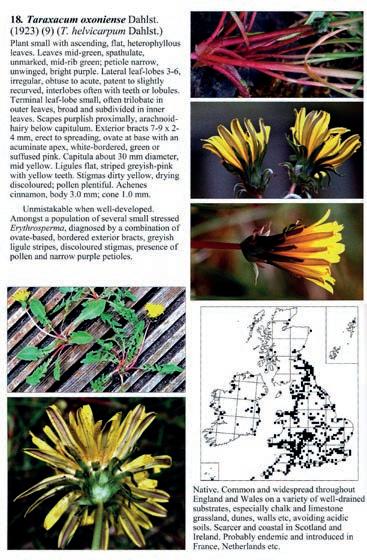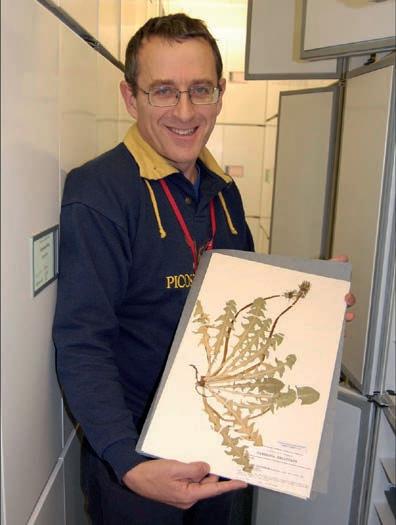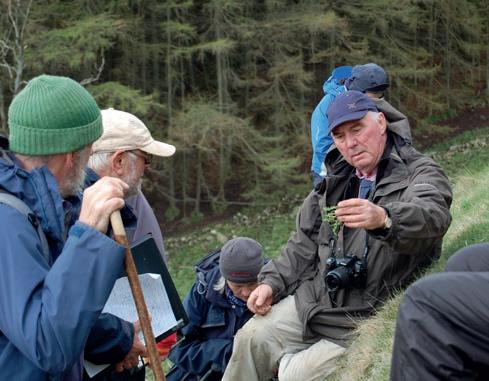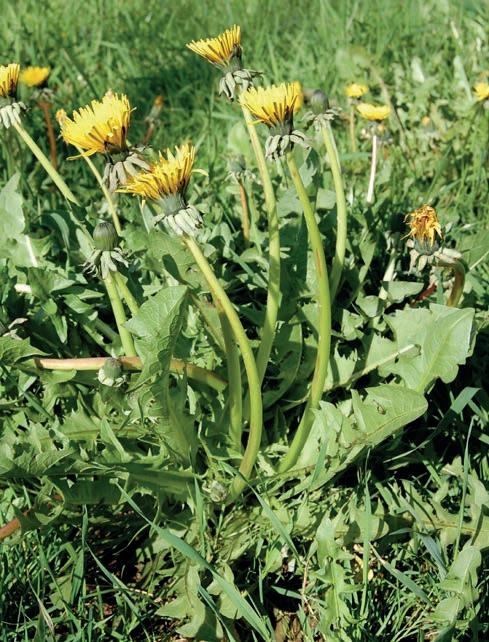
10 minute read
February 2022 BSBI ©2021 ISSN 0309-930X
Figure 1. Part of the Taraxacum oxoniense account from the latest BSBI Handbook on Dandelions. Reproduced with permission of BSBI and John Richards.
Herbaria Herbarium collections allow comparison of species side by side and allow named vouchers to be matched against unknown material. Initially for each difficult group, it is best to focus on national collections created by, or revised by, experts as these are more likely to be named correctly and they show the development of the taxonomy with time. To be useful, the collections need to be kept up-to-date by taxonomists, for example the superb Rubus collection at the Natural History Museum has been extensively revised by the authoritative amateur David Allen over the last 40 years.
Advertisement
When he retired from Newcastle University, John Richards gave the national Taraxacum herbarium collection to the Welsh National Herbarium, which we then curated, databased and stored (Figure 2). This is now the starting point for dandelion research in Britain; there are also good dandelion collections in Oxford University, Royal Botanic Gardens Edinburgh and the Natural History Museum, though these are somewhat out of date taxonomically. Local museum herbaria are rarely worth looking at unless revised by an expert, and many are now managed by specialist conservators who know how to look after the specimens long term but not how to use them.
Anyone studying difficult plants will need to access such herbaria. There are few computerised catalogues available to plan what to see in advance, it costs to travel and most herbaria are not open at weekends (I was guilty of this at Cardiff – I had a young family). Curators are generally helpful sending images if you know what to ask for, but there is no substitute for seeing the actual specimen when, say, looking at types of hair under a microscope.
Expert opinions Once you have made a provisional identification using the literature or herbarium, confirmation

Figure 2. Part of the National Taraxacum collection in the Welsh National Herbarium in 2007; I look considerably older now as a result of tackling difficult plant groups.
by an expert or referee – if there is one – is the next step. Usually this requires dried specimens to be posted but sometimes photographs are sufficient if they show the right features (they are rarely sufficient for hawkweeds). The BSBI have a series of voluntary referees for difficult groups who provide identifications for BSBI members, and some museums/institutions have enquiry services. For dandelions there is only one BSBI referee so at busy times it may take a while to get material named. These days, experts are expected to be on Twitter or Instagram to give an instant diagnosis to anyone who asks. Not all experts agree, and I know some of my identifications even of well-presented material are less than perfect.
Distribution databases Distribution databases can show which species are mostly likely to be found or, for well recorded sites, what is already known. The more difficult the plant group, the more the distribution databases and maps reflect the distribution of the botanists working on the group and the less complete they are. The specialist databases maintained by experts are probably the only ones to trust (some are included in the BSBI ‘Big Database’) as most general databases (such as the NBN Atlas) are out-of-date with lots of errors. For hawkweeds, I usually summarise which species have been previously recorded from a particularl cliff or mountain, but for dandelions were there may be 30 species in a meadow the patchy data are rarely specific enough to be much use. Expert determinations should be to the relevant Vice-county Recorders and/or added to databases such as iRecord to ensure the data are used.
Internet resources The huge potential for the internet to provide access to multiple images and help with identification is in its infancy. Anyone googling pictures knows how few reliable pictures there are on the internet, but you may find specialised websites you can trust. For example, there are verified pictures of Cardiff dandelions (Rich, 2011) with others uploaded to iSpot as ‘dandelion of the day’ (www.ispotnature. org). The Taraxacum Netherlands website has pictures of their section Taraxacum species (www. taraxacumnederland.nl) which partially overlap with our species.
Some difficult plant groups have specific Facebook pages set up to help with identification and to share knowledge – the ‘Dandelions (Taraxacum) of Britain and Ireland’ page has an astonishing 883 members; there is the usual inevitable range of opinions, but it does enable beginners to get started. I have also made some short introductory YouTube videos about identification of some of my hawkweeds1 which I hope are useful summaries despite the camerawork.
In general, identification apps are currently little use for difficult plants as they do not have sufficient data behind them. I toyed with interactive Bayesian multiple access keys on iSpot but their success rate was significantly lower than for conventional keys (e.g. Hieracium section Alpestria www.ispotnature.org/ webkeys, and two draft dandelion section keys which never worked satisfactorily). No doubt such resources will improve as the software improves.
DNA DNA analyses using various methods has provided many insights into difficult groups, and they have revolutionised our understanding of taxonomy and evolution in whitebeams Sorbus (Rich et al., 2010). It takes significant financial resources and time to build up sufficient samples for a DNA reference library but the biggest limitation is finding an interested molecular biologist. As yet there have been no detailed studies of British dandelion DNA; clearly a project for the future.
Learning a difficult plant group
The two main approaches to learn a difficult plant group are taxonomic and geographic. Taking a taxonomic approach means attempting to cover the whole group, or at least a discrete subgroup. For example I have studied the relatively small
1 ‘Tim’s Botanical Riches’ YouTube video (2021): www. youtube.com/channel/UCGRlIWNJXcR1B-S-pzIRTlw
British hawkweed sections Alpestria and Foliosa in detail, but have no plans to cover the whole genus in similar style. Taking a geographical approach means looking at all the species within a specific area, which reduces the number of taxa to manageable proportions; an outstanding example of this approach is Vincent Jones’ (2014) 30-year study of hawkweeds in Yorkshire. Getting to know a few local taxa first and building up knowledge over time is often the easier way to start. Local Floras can indicate what is known, but for some groups they are little more than brief summaries; contrast Mike Shaw’s excellent Sussex hawkweed account with my woefully inadequate dandelion account which was largely based on limited fieldwork during family visits (Abraham et al., 2018).
It helps to compile what is known from the different resources before starting fieldwork to get an overview, but you can learn as you go along. Once you start fieldwork, do it properly: collect plants, take photographs, make notes, revise, review and document.
Perhaps the most important starting point is to go on a training course or workshop run by an expert to learn some common species (anyone remembering more than 15 new taxa in a day is doing well). John Richards has been running annual dandelion workshops around Britain and Ireland since 2013 which have been enormously popular and productive (Figure 3) – those attending the full Breckland workshop in 2019 saw 18 species of Taraxacum section Erythrosperma alone. It is equally important to use the training course to learn how to interpret the characters as there may be catches; for example, the pink colouration in dandelion petioles becomes much more obvious in dried material than fresh material, and may develop in the plant press from apparently white petioles!
Anyone studying difficult plants must create their own herbarium, providing collecting is done responsibly (see BSBI Code of Conduct2). Good material selected to show the key characters collected
2 bsbi.org/wp-content/uploads/dlm_uploads/Code-of-Conductv5-final.pdf Figure 3. John Richards demonstrating dandelions, Blairgowrie workshop 2013. Tim Rich

in the right season is essential but what is needed differs in the different plant groups. For whitebeams, the sterile lateral rosette leaves are essential and ripe fruit help (Rich et al. 2010). In dandelions, the earlyseason leaves with petioles, mature buds and open flowers with, for some species, ripe seeds are needed (Richards 2021). The material needs to be properly collected too – it is essential to dry dandelions quickly to retain colouration, which may involve changing the drying paper in a plant press twice a day for a week for each specimen (Figure 4). It can be a lot of work pressing, drying, labelling, mounting and storing specimens, and high quality materials can be expensive. My working collection is glued with PVA onto thin A3 card stored in re-sealable plastic bags which are routinely frozen to minimise pests like booklice which is not ideal. Longer term the specimens will be deposited in a proper herbarium. With fieldwork, it may be best to concentrate on what is obviously different, rather than struggling with every plant. In Cardiff, I tried to select a few distinctive dandelions from each of many different sites, but still ended up collecting far too much of the variable T. aequilobum. I took photographs of the plants in situ so I could recognise them again as they looked so different to the dried specimens. I found more species on return visits once I had my eye in.

Figure 4. Drying dandelion pressing paper in hotel room, BSBI Workshop, Bute 2017. Tim Rich

Figure 5. An unknown Cardiff dandelion, nicknamed the ‘Pantmawr Giant’, possibly new to science. Tim Rich I learned not to collect trampled or mown plants, those in fertile pastures or those in shaded woodland, however distinctive they appeared. Within three years I was surprised to find I had collected 110 species and two unknown species (Figure 5); it is going to take an enormous amount of research across Europe to determine if they are new to science but such finds can be among the rewards for tackling difficult plant groups.
Acknowledgments
I would like to thank John Richards for his worldclass inspiration, patience and time spent helping me learn Taraxacum as measured on the dandelion clock.
References
Abraham, F., Briggs, M., Harmes, P., Hoare, A., Knapp, A.,
Lording, T., Scott, B., Shaw, M., Streeter, D. & Sturt, N. 2018. The flora of Sussex. Pisces Publications, Newbury. Armstrong, J. V. & Sell, P.D. 2018. Ulmus L., in Sell, P.D. &
Murrell, J.G. Flora of Great Britain and Ireland. 1: 264–305.
Cambridge University Press, Cambridge. Cowan, R.S., Smith, R. J., Fay, M.F. & Rich, T.C.G. 2008.
Genetic variation in Irish Whitebeam, Sorbus hibernica E. F.
Warb. (Rosaceae) and its relationship to a Sorbus from the
Menai Strait, North Wales. Watsonia 27: 99–108. Dudman, A.A. & Richards, A.J. 1997. Dandelions of Great
Britain and Ireland. BSBI Handbook 9. Botanical Society of the British Isles, London. Gill, E. 2007. Conservation genetics of the species complex
Cochlearia officinalis s.l. in Britain. PhD thesis, University of Edinburgh. Jones, V. 2014. Yorkshire hawkweeds. Yorkshire Naturalists’
Union, York. Kirschner J., Oplaat C., Verhoeven K.J.F., Zeisek V.,
Uhlemann I., Trávníček B., Räsänen J., Wilschut R.
A. & Štěpánek J. 2016. Identification of oligoclonal agamospermous microspecies: taxonomic specialists versus microsatellites. Preslia 88: 1–17. Ludwig, S., Robertson, A., Rich, T.C.G., Djordjević, M.,
Cerović, R., Houston, L., Harris, S.A. & Hiscock, S.J. 2013. Breeding systems, hybridisation and continuing evolution in Avon Gorge Sorbus. Annals of Botany 111: 563–575. Newton, A. & Randall, R.D. 2004. Atlas of British and Irish
Brambles. Botanical Society of the British Isles, London. Proctor, M.C.F. 1999. Sorbus L. (Rosaceae). In Wigginton,
M.J. British Red Data Books. 1 Vascular plants (3rd edn). Joint
Nature Conservation Committee, Peterborough. Rich, T.C.G. 2002. Conservation of Britain’s biodiversity:
Hieracium asteridiophyllum and H. cillense (Asteraceae).
Watsonia 24: 101–106.










